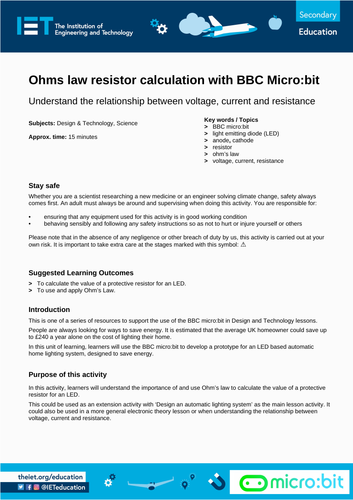


In this activity students will learn about importance of and use Ohm’s law to calculate the value of a protective resistor for an LED. Using a BBC micro:bit, they will develop a prototype for an LED based automatic home lighting system, designed to save energy.
This prototype aims to promote energy efficiency, a concern that resonates with our daily life as it’s estimated that the average UK homeowner could save up to £240 a year alone on the cost of lighting their home.
This is one of a set of resources developed to aid the teaching of the secondary national curriculum, particularly KS3. This is part of our series of resources designed to support the use of the BBC micro:bit in secondary school design & technology (DT), computing and engineering lessons. It can also be used to support physics sciences lessons.
Activity: Developing a prototype for an LED based automatic home lighting system
In this sustainable lighting activity, students will be tasked with creating a smart lighting system that adjusts based on environmental conditions.
The engineering context
Engineers are often required to program devices to perform specific tasks, optimise system performance, or even create entirely new technologies. This involves understanding how to embed intelligence into products, which can range from simple household items like automatic lighting systems to more complex systems like autonomous vehicles or smart city infrastructure.
By learning programming skills and understanding how to integrate them into engineering projects, students will gain an insight into how different components can work together in a system.
Furthermore, resistors are essential components in electronic circuits, controlling the flow of electricity and protecting components from damage by limiting the current. Understanding Ohm’s law and resistor calculation will lay the groundwork for many aspects of electronics and electrical engineering.
Suggested learning outcomes
By the end of this activity, students should be able to understand and apply Ohm’s Law, particularly in calculating the value of a protective resistor for an LED. The skills they acquire will extend beyond the classroom, equipping them with practical knowledge that can be applied in real-world situations. This activity will also set a solid foundation for more complex electronic theory lessons or when delving deeper into the relationship between voltage, current, and resistance.
Download our activity sheets for free!
The activity sheet includes teachers’ notes, useful web links, and links (where appropriate) to the national curriculum in each of the four devolved nations; England, Northern Ireland, Scotland and Wales.
All activity sheets and supporting resources are free to download, and all the documents are fully editable, so you can tailor them to your students’ and your schools’ needs.
Please do share your highlights with us @IETeducation
Something went wrong, please try again later.
This resource hasn't been reviewed yet
To ensure quality for our reviews, only customers who have downloaded this resource can review it
Report this resourceto let us know if it violates our terms and conditions.
Our customer service team will review your report and will be in touch.